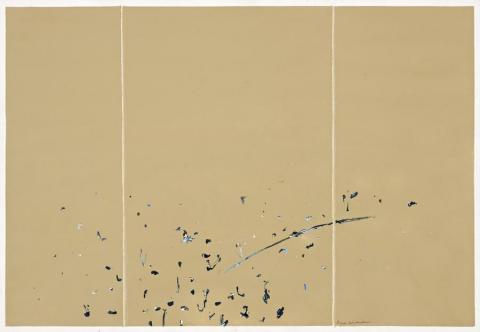AUSTRALIAN LANDSCAPE, 1969
FRED WILLIAMS
gouache on paper
56.5 x 76.5 cm
signed lower right: Fred Williams
Estate of the artist, Melbourne (cat. GW 600, label attached verso)
Philip Bacon Galleries, Brisbane (label attached verso)
Private collection, Queensland
Fred Williams's landscapes of the sixties have been often described as a series of conversations; one body of work answering and informing the questions and complexities of the next. By the late 1960s Williams had embarked upon the first of what would be the Australian Landscape works, a period of abstract minimalism which Robert Lindsay interpreted 'as a counterbalance to the weight and solidity of the Upwey series'.1 First titled Forest of Gums then Divided Landscapes, Williams finally titled the series Australian Landscapes in recognition of what he described as the Australian landscape with its skin taken off.2 Without the minor differences of region, he was finally describing the bedrock of the landscape.
Free of the horizon line, the landscape's depth in our picture is described by a deft arc whose more exaggerated form can be located in the Hummock and Hillock series of the mid 1960s. Like an arm rotating on the fulcrum of the elbow, the resulting line with its clustering framework of trees pushes a valley into the foreground. The device is more fully manifested in Cottlesbridge, an oil of the same period now in the collection of the Metropolitan Museum of Art in New York, whose picture plane is dominated by a broad sweep which loops back upon itself, gathering up saplings and hillside in its embrace. That such a gestural fragment can invoke depth and enliven the composition is evidence of Williams's highly evolved visual language; so economic and delicate, yet immediately recognisable.
Like many of the Australian Landscapes, here Williams has divided the composition vertically. Patrick McCaughey traces the origin of this formal device to the more guttural marks of the You Yangs series. 'The idea of the vertical dividing line comes from fence and road lines with clusters of trees growing along them, seen from the air.'3 Refined to the point of abstraction, Williams takes the landscape right to the brink of minimalism without departing from the subject completely.
1. Lindsay, R., Fred Williams, Works in the National Gallery of Victoria, National Gallery of Victoria, Melbourne, 1980, p. 31
2. McCaughey, P., Fred Williams, 1927-1982, Murdoch Books, Sydney, 2008, p. 216
3. Ibid, p. 217
MERRYN SCHRIEVER
